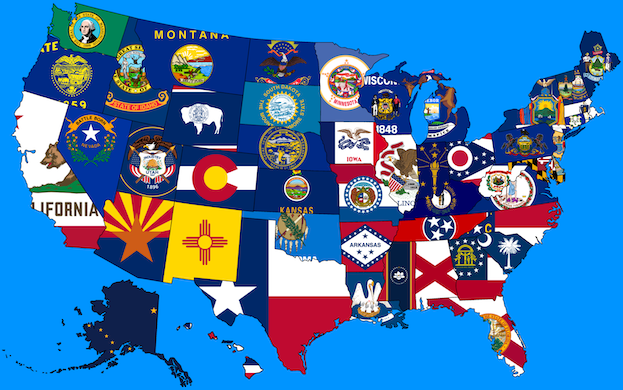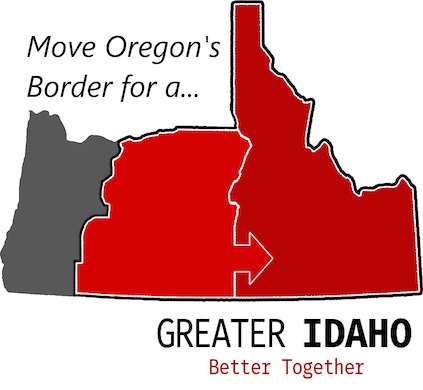2022 Sees Raft of Secession Initiatives and Votes To Change State Borders
Non-binding measures signal partisan divide as ‘small politics’ starts to spread.

Talk of “national divorce,” secession, and state border changes ramped up in 2022 with the passage of several secession ballot measures across the country, but the idea that this will lead to any revised borders or new states is a long shot.
What the passage of these non-binding secession measures signals, reporting by the Sun suggests, is a partisan divide in this country and dissatisfaction among the political minority, mainly in blue states. Americans unwilling to wait for border or policy changes voted with their feet in 2022, expanding, in the years since Covid, a trend of Americans fleeing blue states like California, Illinois, and New York for red ones, mainly Texas and Florida, according to the Census Bureau.
“Things like abortion, guns, Covid were really good at accelerating this process in terms of people recognizing maybe for the first time that which state government you live in actually matters,” a Mises Institute economist, Ryan McMaken, author of “Breaking Away: The Case for Secession, Radical Decentralization, and Small Polities,” tells the Sun.
In November, two eastern Oregon counties voted in favor of ballot measures to explore leaving the Beaver State and joining Idaho. The Greater Idaho movement that initiated these ballot measures is seeking to move the border between Idaho and Oregon westward to the Cascade Mountains in order to incorporate 15 mainly rural, Republican-leaning counties into Idaho. Since the movement’s founding in 2019, 11 of 15 counties have voted in favor of joining Idaho.
“The border where it is now doesn’t represent where the cultural divide is in our state,” Greater Idaho’s spokesman, Matt McCaw, tells the Sun. He says eastern Oregonians have more in common with Idahoans than they do with residents of Portland or Eugene. This references from how they vote to how they earn a living through ranching and a reliance on natural resources.

Mr. McCaw also points to the state’s drug decriminalization, the recently passed ballot measure restricting gun rights, and other liberal policies that are favored by voters in western Oregon’s population centers but rejected by those in the rural east.
Partisan rancor is not unique to Oregon. Two-thirds of Americans say political divisions have widened since the beginning of 2021, with 43 percent of Americans believing a civil war is “somewhat likely” in the next 10 years, according to an August 2022 YouGov/Economist poll. More Republicans than Democrats think political division is an increasingly intractable problem.
The idea of changing the state border “is part of a long and larger conversation about lowering the political temperature in this country and dealing with increasing polarization,” Mr. McCaw says. “Things like national divorce come up — I think border relocation is the future because it solves those problems.”
The Greater Idaho ballot measures, though non-binding, are primarily useful as a demonstration of resident support for leaving Oregon, Mr. McCaw says. The next step to effectuate an actual border change is to introduce a bill in the Oregon state legislature. He says that the movement already has a legislator who is committed to doing this in early 2023 and that an announcement is imminent.
If the bill to redraw the border were to pass in Oregon, the following step would be to bring the measure to Idaho’s state legislature. Finally, per the Constitution, congressional approval would also be required. Mr. McCaw is optimistic about the prospects.
“We think there is a very good chance that people would approve it, because there’s no good reason not to,” Mr. McCaw says. “Self-determination is a core principle of the United States.”
In Illinois, two counties and two townships also voted in favor of secession ballot measures in November. The measures asked if voters wanted their county boards to explore the idea of separating from Cook County — where Chicago is situated — and forming a new state.
So far, 27 southern Illinois counties have voted in favor of exploring secession. The grievances from residents of these counties echo those of the Greater Idaho movement: Chicago and its surrounding suburbs dominate state politics, but their priorities and policies run counter to the wishes and requirements of residents in rural, conservative southern Illinois.
“The neighboring states — Missouri, Indiana, Kentucky— all fit better politically,” a Jersey County board member, Eric Ivers, who supports secession, tells the Sun. “They’ve been talking about this all my life, and I’m 73.”
Mr. Ivers points to differences in opinion regarding gun-control laws, taxes, and education policies — among other issues — that he says constitute an insurmountable cultural divide between southern and northern Illinois. He also points to the red-blue election maps that show southern Illinois deep red, while Cook County is solidly blue.
Mr. Ivers, though, says the ballot measures should have been written to look more like the ones in Oregon that pushed to join a neighboring state. “The odds of ever being able to form a separate state are miniscule,” he says, since adding a new red state would alter the Senate balance. “To me the secession is not to form a new state, it’s secession from the state of Illinois.”
In San Bernardino County, California, the largest county in the United States, residents voted by a slim margin in November for county officials to explore the possibility of seceding and forming a new state, the Inland Empire. This potential new state would be geographically larger than New Jersey, Connecticut, Rhode Island, and Delaware combined.
Unlike the Illinois and Oregon counties that passed secession measures, San Bernardino is a racially diverse, purple county where Democrats outnumber Republicans. At issue is not a partisan divide per se, but “a lot of frustration overall” about rising housing costs, homelessness, and crime, while residents pay some of the highest taxes in the nation, the chairman of the county’s Board of Supervisors, Curt Hagman, says.
A major complaint is how Sacramento spends tax dollars and whether a fair share returns to the Inland Empire. The governor’s extended Covid restrictions and school closures also played into the vote. Despite the county leaning more Democratic, Governor Newsom lost his 2021 recall election there by five points.
This is not the first attempt to break up California into multiple states. The longest standing, currently active secession movement is the State of Jefferson. Active in one form or another since 1941, it seeks to break off several rural, conservative counties in northern California and Southern Oregon to create a new state.
Like all the other current secession movements, the San Bernardino exodus faces an uphill challenge. “It’s very hard to see a way in which the very local interests that are pushing something like a regional secession would ever really get a fair hearing in an organization like the House of Representatives or the Senate,” Mr. McMaken says. He’s more sanguine, though, about the prospects if dedicated parties continue to advocate on a national level for state border revision as a remedy to political disunity.
“I think the more we see it happen, the more likely it will occur at some point in the medium or long-term future,” Mr. McMaken says.
State secession from the United States also got a hearing in 2022. In March, New Hampshire legislators voted on a bill proposing a constitutional amendment for the Granite State to secede from the United States. While the legislation failed with only 13 supporting votes, the NH Exit movement is still active in the state, mainly among libertarians of the Free State Project. Their movement centers on a political concentration strategy of bringing “liberty lovers” to the state to influence politics and creating a libertarian homeland.

In June, the Texit movement earned a key endorsement, when the Texas State Republican Convention adopted a platform pushing for a referendum in 2023 “to determine whether or not the State of Texas should reassert its status as an independent nation.” Under Republican leadership, Texas, like Florida, has waded deeply into the partisan culture wars, acting as a foil to the Biden administration on abortion, transgender care for children, immigration, and gun rights.
While all these secession-related movements are in their infancies and, for now, seem unlikely to succeed, they mirror trends happening nationally with inter-state migration. While it’s unclear how much politics plays into these moves or whether it’s the byproduct of politics — economic factors and Covid restrictions like school closures being the most obvious — Americans are increasingly sorting themselves geographically by political affiliation.
The number of “super landslide” counties, where either the Democrat or Republican candidate earned more than 80 percent of the vote, increased to 22 percent in 2020, from less than 10 percent in 2012. These moves have accelerated in the last two years, as remote work enabled many to relocate to low-tax cities in the Sun Belt from big cities in high-tax states.
The differences in Covid restrictions between states, particularly regarding public schools, awakened many Americans to the importance of state and local government in setting policy.
Border changes worldwide have historically hinged on ethnic and religious differences. If politics is the new religion, then perhaps this “big sort” is a continuation of long-existing patterns, with border revisions its logical conclusion. Yet as sociologist Bill Bishop suggests in his 2008 book, “The Big Sort,” geographic polarization threatens to hollow out the middle.
“Part of the problem is that both sides continue to frame this in Civil War terms,” Mr. McMaken says. Yet he emphasizes that border revisions needn’t be accompanied by violence: “There has to be an ideological change when people start to see U.S. states as true member states and not just provinces or regions of the U.S. government.”
If 2022 is the year of secession ballot measures, then 2023 may be the year of greater decentralization and federalism, as states reassert themselves as the “laboratories of democracy.” From abortion to gun rights to Covid policies and taxes, the differences between states are likely to increase.
For those in the political majority, this may be a win. For those in the minority, talk of secession and border changes will likely escalate.

